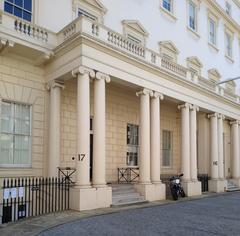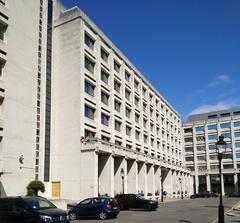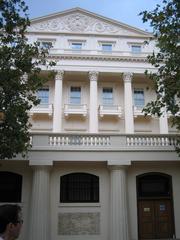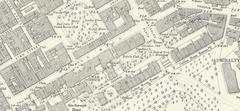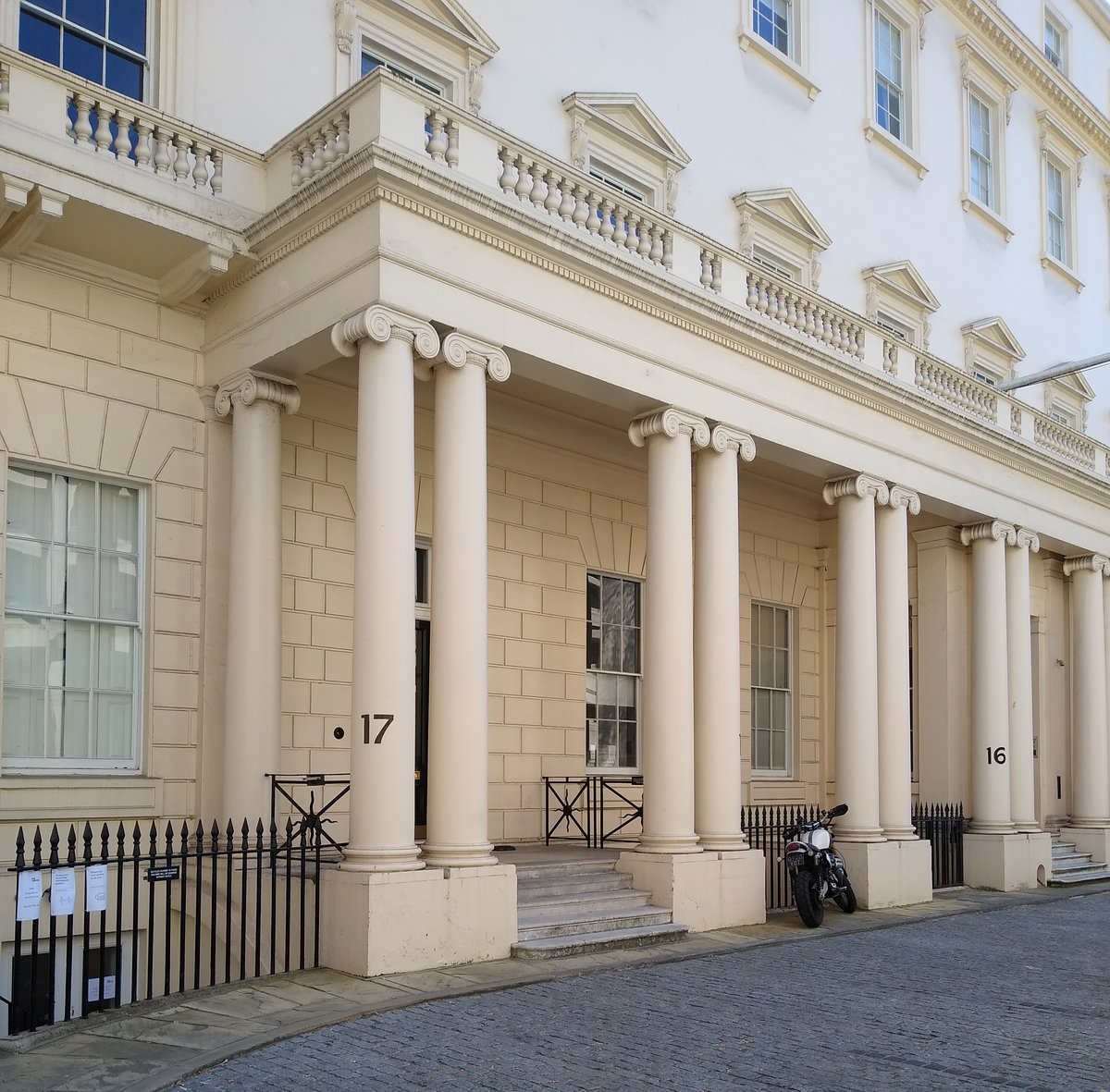
Carlton House Terrace London: Visiting Hours, Tickets, and Historical Sites Guide
Date: 14/06/2025
Introduction
Carlton House Terrace, set in the heart of London’s distinguished St James’s district, is a magnificent showcase of Regency architecture, historical depth, and cultural vibrancy. Overlooking St James’s Park and The Mall, this elegant terrace embodies a story that bridges royal residence, political power, and contemporary intellectual life. Originally the site of Carlton House—the celebrated home of the Prince Regent, later King George IV—the area was transformed in the early 19th century by architect John Nash into the grand terraces that define it today (Wikipedia: Carlton House, A London Inheritance).
Today, Carlton House Terrace is renowned for its architectural splendor, sweeping colonnades, and its links to figures such as British Prime Ministers and cultural institutions like the Royal Society and the British Academy (Prince Philip House, Royal Society Official Website). This guide provides an in-depth overview, from its origins and design to practical visiting information, ensuring you make the most of your visit to this iconic London landmark.
Table of Contents
- Carlton House Terrace: History and Setting
- Visiting Carlton House Terrace: Practical Information
- Frequently Asked Questions (FAQ)
- Architectural and Cultural Significance
- Event Spaces and Modern Facilities
- Visitor Tips and Accessibility
- Transport and Getting Around
- Summary and Travel Tips
- References
Carlton House Terrace: History and Setting
Origins and Early Development
Carlton House Terrace traces its roots to the early 18th century as the site of a grand townhouse—first home to Henry Boyle, Baron Carleton, and later elevated by the Prince of Wales (the future George IV) to a palace of unprecedented luxury (Tripomatic). Architect Henry Holland’s transformation of Carlton House (1783–1796) introduced French neoclassical style to England, and the residence rapidly became the social and political nucleus of Regency London (Wikipedia: Carlton House).
Carlton House: Architectural and Social Significance
The original Carlton House was distinguished by its impressive scale (over 200 feet long), a grand Corinthian portico, and lavish interiors featuring masterpieces by Reynolds, Gainsborough, Rembrandt, and Rubens. Its reputation for opulence and political intrigue was such that it featured in the literature of the period, including Oscar Wilde’s “The Picture of Dorian Gray” (Wikipedia: Carlton House).
Demolition and the Birth of Carlton House Terrace
With George IV’s accession, royal priorities shifted to Buckingham Palace. Carlton House was demolished in 1826, clearing the way for John Nash’s vision: a pair of stately, white stuccoed terraces (Western and Eastern blocks) separated by the Duke of York’s Column. Completed between 1827 and 1832, these terraces provided a ceremonial frame to The Mall and St James’s Park, adding grandeur to London’s urban plan (A London Inheritance).
Architectural Features and Notable Residents
Nash’s terraces are celebrated for their massive Corinthian columns, harmonious Neoclassical details, and innovative arrangements that maximize park views (Fodor’s). Decimus Burton, another prominent architect, designed Nos. 3 and 4. Residents have included Prime Ministers such as William Gladstone and Lord Palmerston, commemorated by blue plaques on the facades (A London Inheritance).
Institutional and Political Legacy
By the late 19th and 20th centuries, many homes were repurposed as institutional headquarters. Notably, Nos. 6–9 house the Royal Society, Britain’s leading scientific institution, and the original offices of the London County Council were also based here (Fodor’s, A London Inheritance). During the Cold War, part of the terrace served as a secret Foreign Office department (Tripomatic).
Urban Context and Surviving Historic Features
The terrace sits between The Mall and Pall Mall, with pedestrian access via the Duke of York’s Steps and historic side streets like Warwick House Street (A London Inheritance). Despite redevelopment, original railings, mews, and stairways endure, offering glimpses into the site’s layered past.
Visiting Carlton House Terrace: Practical Information
- Visiting Hours: The terrace is a public street, open year-round. However, entry to interiors—such as the Royal Society or British Academy—depends on their event schedules. The Royal Society typically opens to the public during exhibitions (10:00–17:00 weekdays), but always check their official website for up-to-date details.
- Tickets and Entry: Walking along the terrace is free. Events and exhibitions at institutions may require tickets or registration. Open House London and similar events offer rare guided tours inside.
- Accessibility: The main street and some public buildings are wheelchair accessible, but stairways and steps may limit access in places. Always confirm accessibility with the host institution.
- Travel Tips: Tube stations Green Park, Charing Cross, and Piccadilly Circus are all a 10-minute walk away. Buses run frequently along The Mall and Pall Mall. Limited parking; public transport is strongly recommended.
- Nearby Attractions: Buckingham Palace, Trafalgar Square, St James’s Park, and the National Gallery are within walking distance.
Guided Tours and Events
Guided tours are offered during select open days and by private operators. Public lectures, exhibitions, and science festivals are hosted by the Royal Society and British Academy. Photography is permitted in public areas and during most events (check individual policies).
Frequently Asked Questions (FAQ)
Q: Can I visit the interiors of Carlton House Terrace buildings?
A: Most buildings are private or institutional, but the Royal Society and British Academy host public events and occasional tours.
Q: Are there entrance fees?
A: No fee to walk the terrace; event entry may require booking/tickets.
Q: When is the best time to visit?
A: Spring and summer offer pleasant park views. Early mornings and late afternoons provide optimal lighting for photography.
Q: Is the terrace family-friendly?
A: Yes, especially when combined with visits to nearby parks and landmarks.
Q: Are guided tours available?
A: Yes, during special events or by arrangement through cultural institutions and some tour operators.
Architectural and Cultural Significance
Urban Planning and Neoclassical Grandeur
Carlton House Terrace is a Regency urban masterpiece by John Nash, designed as a ceremonial frame for St James’s Park and The Mall (British History Online). Only the two northern terraces were realized, each with four storeys above a basement and a grand Corinthian colonnade facing St James’s Park (Prince Philip House). The absence of rear mews is unique; service quarters are ingeniously located beneath the podium.
Architectural Collaboration and Heritage Status
Nash’s vision was executed with contributions from Decimus Burton and James Pennethorne (Wikipedia). Interiors were customized for aristocratic residents; some original features, like the black marble staircase at No. 10 and gold ceiling in the Council Room, remain (10-11 Carlton House Terrace). The terraces are Grade I listed, and their lamp standards and certain bollards are individually Grade II listed, ensuring rigorous preservation (Wikipedia).
Cultural Evolution
Initially an address for the elite, Carlton House Terrace later became a hub for learned societies and national bodies, now home to the British Academy and Royal Academy of Engineering (Prince Philip House; Living London History). It regularly features in literature and drama and is a venue for public engagement, lectures, and exhibitions (10-11 Carlton House Terrace).
Event Spaces and Modern Facilities
Especially at 10-11 Carlton House Terrace, a recent £9.6 million redevelopment has melded historic charm with contemporary amenities:
- Lower Ground Floor: The SHAPE Room hosts hybrid events for up to 125 guests; the Lecture Room and Wohl Gallery offer flexible, modern spaces.
- First Floor: Historic reception rooms feature ornate ceilings and panoramic views.
- Ground Floor: Reimagined period rooms for intimate gatherings.
- Sustainability: The UK’s first Grade I listed building with double-glazed windows and a carbon-free heating system.
Visitor Tips and Accessibility
- Accessibility: Step-free access, platform lifts, and accessible toilets available. Hearing support systems are provided. Contact the venue for specific needs (10-11 Carlton House Terrace).
- Parking: Limited; use public transport or taxis. Blue Badge parking can be arranged.
- Dress and Weather: Layered clothing and sensible footwear are advised, especially for outdoor events and garden access.
- Photography: Allowed during public events; follow house rules during private functions.
- Security: Cloakrooms for events; keep valuables to a minimum.
- Wi-Fi: Free Wi-Fi available throughout the venue.
- Health & Safety: Staff are trained in first aid; emergency services: dial 999 (Londondrum).
Transport and Getting Around
- Underground: Charing Cross, Green Park, and Piccadilly Circus stations are nearby.
- Bus: Numerous routes serve The Mall, Trafalgar Square, and Piccadilly.
- Rail: Charing Cross and Victoria stations for mainline connections.
- Cycling: Santander Cycles docking stations nearby.
- Taxis/Ride-hailing: Black cabs and app-based services readily available.
Summary and Travel Tips
Carlton House Terrace is a distinguished symbol of Regency elegance and British heritage. From its royal origins to its present role as a home for Britain’s cultural and scientific elite, it captivates visitors with its architecture, history, and views (Wikipedia: Carlton House Terrace, Living London History). While general access is limited to public areas and events, open days and special exhibitions unlock opportunities to explore its interiors. Use public transport for ease, and consider combining your visit with nearby landmarks such as Buckingham Palace and Trafalgar Square.
Stay connected by downloading the Audiala app for updates and exclusive content, and follow related social media channels for the latest news. Carlton House Terrace offers an enduring journey through London’s regal history and vibrant cultural scene.
References
- A London Inheritance: Carlton House Terrace
- Living London History: Secrets and Stories of the British Academy
- Royal Society: Carlton House Terrace
- 10-11 Carlton House Terrace Venue Guide
- Wikipedia: Carlton House
- Wikipedia: Carlton House Terrace
- Prince Philip House: Carlton House Terrace
- Fodor’s Travel: Carlton House Terrace
- Tripomatic: Carlton House Terrace
- Memoirs of a Metro Girl: Royal Society Carlton House Terrace
- British History Online: Survey of London
- Londondrum Visitor Information
- Time Out: Top London Attractions
- NHS: Health Services
Caption: Iconic view of Carlton House Terrace overlooking St James’s Park.
Caption: Stunning Regency architecture with Corinthian columns at Carlton House Terrace.
For more on London’s history and visitor planning:
